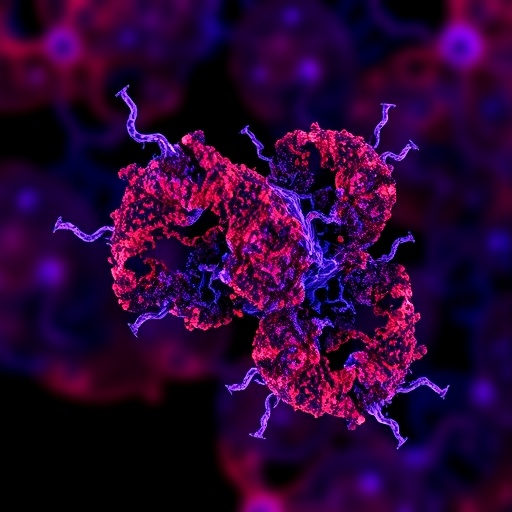In the rapidly evolving landscape of cancer research, the intricate molecular dialogues that dictate tumor behavior have become a focal point for transformative therapies. Among these, the Hippo signaling pathway, particularly the effectors YAP (Yes-associated protein) and TAZ (transcriptional co-activator with PDZ-binding motif), have emerged as pivotal players in orchestrating cellular proliferation, survival, and metastasis. Recent research underscores the profound influence of noncoding RNAs (ncRNAs) as regulators and potential therapeutic targets within the YAP/TAZ axis, an insight that promises a paradigm shift, especially in the context of colorectal cancer (CRC).
Colorectal cancer remains one of the leading causes of cancer-associated mortality worldwide, largely due to its complex pathogenesis and heterogeneity. Standard treatments, though moderately effective, often face the barrier of chemoresistance and metastatic progression. Understanding the molecular underpinnings that drive these therapeutic obstacles is critical. In this light, the study by Mostafavi et al. illuminates how ncRNAs, traditionally considered transcriptional noise, are in fact master regulators of the Hippo pathway components, thereby modulating the behavior of YAP/TAZ in CRC.
NcRNAs encompass a broad category of RNA molecules that do not encode proteins but exert substantial influence on gene expression regulation. This diverse group includes microRNAs (miRNAs), long noncoding RNAs (lncRNAs), and circular RNAs (circRNAs), each contributing distinctive mechanistic roles in cellular signaling cascades. The study emphasizes the bidirectional crosstalk between these ncRNAs and the YAP/TAZ pathway, showing that ncRNAs can either promote or inhibit YAP/TAZ activity depending on their origin and downstream targets.
One of the remarkable revelations is how certain miRNAs can directly bind to messenger RNAs encoding YAP/TAZ or their upstream regulators, thus dampening or enhancing the pathway’s signaling output. This post-transcriptional regulation is critical in maintaining cellular homeostasis and, when dysregulated, can lead to unchecked cellular proliferation typical of malignant tumors. For example, miR-375 has been identified as a suppressor that directly targets YAP transcripts, attenuating its oncogenic potential in colorectal epithelial cells.
Furthermore, the complexity deepens as lncRNAs act not only as molecular sponges that sequester miRNAs away from YAP/TAZ mRNA targets but also as scaffolds facilitating the assembly of transcriptional complexes essential for YAP/TAZ nuclear function. This multi-layered regulation allows lncRNAs to fine-tune the Hippo pathway dynamically in response to extracellular stimuli, such as mechanical stress or metabolic cues, which are abundant within the tumor microenvironment.
Circular RNAs, relatively novel entrants in the ncRNA family, add yet another layer of control by forming stable, covalently closed loops resistant to exonuclease degradation. They can sequester specific microRNAs or directly interact with proteins involved in YAP/TAZ signaling, thus modulating pathway activity with unprecedented stability. This characteristic positions circRNAs as not only critical biological regulators but also attractive candidates for biomarker development in CRC prognosis and therapy response prediction.
The interplay between ncRNAs and YAP/TAZ is not confined to intracellular events; it extends into the domain of tumor microenvironment remodeling. YAP/TAZ activation influenced by ncRNAs can drive the secretion of pro-inflammatory cytokines and extracellular matrix components that facilitate tumor invasion and immune evasion. Consequently, ncRNAs emerge as key orchestrators of tumor-stroma interactions pivotal to colorectal cancer progression.
Therapeutically, targeting ncRNAs that modulate YAP/TAZ offers a twofold advantage. Firstly, it provides specificity by aiming at upstream regulators rather than the ubiquitous YAP/TAZ proteins themselves, reducing off-target effects. Secondly, this strategy can overcome resistance mechanisms inherent in CRC cells by disrupting the compensatory feedback loops within the Hippo pathway. The study by Mostafavi et al. highlights innovative approaches such as antisense oligonucleotides, miRNA mimics, and small molecule inhibitors tailored to restore the homeostatic balance of ncRNA-mediated control.
Experimental models further validate these concepts, showing that manipulating specific ncRNAs results in decreased tumor growth and metastasis in murine CRC models. These findings propel ncRNA-targeted therapies from a theoretical framework into tangible clinical potential. However, challenges remain in the efficient and safe delivery of these nucleic acid-based agents to target tissues, emphasizing the need for continued advancements in nanocarrier technology and tissue-specific promoters.
The clinical implications of this research are profound. Integrating ncRNA profiles with current genomic and proteomic data could enhance patient stratification, enabling personalized medicine approaches that optimize therapeutic outcomes. Biomarker panels incorporating ncRNAs associated with YAP/TAZ signaling may predict the likelihood of metastasis or therapeutic resistance, guiding treatment decisions in real time.
Moreover, understanding the temporal dynamics of ncRNA expression and YAP/TAZ activity could shed light on the stages of colorectal tumorigenesis when intervention would be most efficacious. Such knowledge might facilitate early detection strategies and preventive measures alongside conventional therapies, ultimately improving patient survival and quality of life.
The convergence of noncoding RNA biology with the Hippo pathway exemplifies the elegant complexity of cellular regulation and underscores the necessity of multifaceted approaches in cancer therapy development. As research delves deeper into these molecular interdependencies, previously “undruggable” pathways like YAP/TAZ are becoming accessible, marking a turning point in oncological therapeutics.
In conclusion, the insights brought forth by Mostafavi and colleagues underscore noncoding RNAs as essential mechanistic regulators and promising therapeutic modulators of YAP/TAZ signaling in colorectal cancer. This nexus between ncRNAs and the Hippo pathway not only advances fundamental understanding of tumor biology but also charts new paths for innovative, targeted treatments poised to combat one of the most prevalent and deadly malignancies globally. The future of CRC therapy may well hinge on harnessing the subtle, yet powerful, influence of noncoding RNAs within the YAP/TAZ framework.
Subject of Research: Regulation of YAP/TAZ signaling by noncoding RNAs in colorectal cancer.
Article Title: Noncoding RNAs as mechanistic regulators and therapeutic modulators of YAP/TAZ signaling in colorectal cancer.
Article References:
Mostafavi, M., Dehbashi, E., Rahmani Khajeh, F. et al. Noncoding RNAs as mechanistic regulators and therapeutic modulators of YAP/TAZ signaling in colorectal cancer. Med Oncol 42, 357 (2025). https://doi.org/10.1007/s12032-025-02934-8
Image Credits: AI Generated




